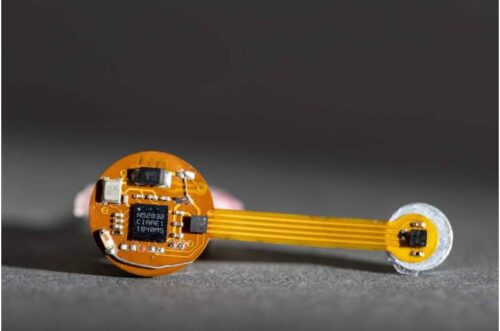The Thermal Earring tracks health by monitoring earlobe temperature, spotting fever, stress, and more with style.

Smart gadgets are becoming more ubiquitous. Rings and watches now monitor health stats, and Ray-Bans have been upgraded with cameras and microphones. Even brooches have embraced wearable technology. However, some accessories still need to be enhanced with smart features.
Researchers at the University of Washington have developed the Thermal Earring, a wireless device that continuously tracks the temperature of the wearer’s earlobe. In a trial involving six participants, this innovative earring proved more accurate than a smartwatch in measuring skin temperature during rest periods. It also demonstrated potential for detecting stress indicators, eating, physical activity, and ovulation signals.
This smart earring, roughly the size and weight of a small paperclip, boasts a battery life of 28 days. It uses a magnetic clip to secure one temperature sensor onto the earlobe while a second sensor hangs approximately an inch below to gauge ambient temperature. Users can customize the earring with fashion-forward designs, such as floral-shaped resin or gemstones, without compromising its measurement precision.
Designing a wearable device small enough to resemble an earring while ensuring a battery life that only requires charging every few days posed a significant engineering challenge.
The team optimized the earring’s energy use while accommodating a Bluetooth chip, a battery, temperature sensors, and an antenna. To conserve energy, instead of maintaining a constant pairing with another device, which consumes more power, the earring employs Bluetooth advertising mode. This mode involves sending out signals that are available for pairing. Once it has taken and transmitted the temperature readings, the earring enters a deep sleep mode to save energy further.
Given that continuous monitoring of earlobe temperature is a relatively unexplored area, the researchers also investigated its possible uses to shape future studies. In observing five feverish patients, the earlobe temperature increased by an average of 10.62 degrees Fahrenheit (5.92 degrees Celsius) compared to 20 healthy individuals. This finding indicates the earring’s capacity for ongoing fever detection.
Reference: Qiuyue Shirley Xue et al, Thermal Earring, Proceedings of the ACM on Interactive, Mobile, Wearable and Ubiquitous Technologies (2024). DOI: 10.1145/3631440






